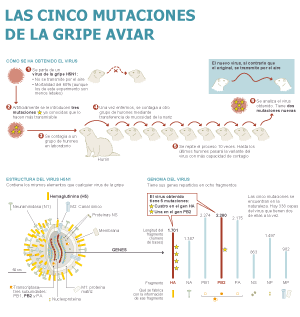哺乳類H5N1鳥のウイルスが伝染する5変異を掲示
Posted the five mutations that make the virus transmissible in mammals H5N1 avian
El primer virus de la nueva era
Publicadas las cinco mutaciones que hacen al virus aviar H5N1 transmisible en mamíferos
Ya hay agentes naturales con dos de ellas
Un arma secreta de cinco letras
Entrevista con Ron Fouchier
Javier Sampedro Madrid 21 JUN 2012 - 20:07 CET
epidemiólogos.
 ampliar foto
ampliar foto
HEBER LONGÁS / EL PAÍS
The first virus of the new era
Posted the five mutations that make the virus transmissible in mammals H5N1 avian
There are already natural agents with two of them
Secret weapon of five letters
Interview with Ron Fouchier
Javier Sampedro Madrid 21 JUN 2012 - 20:07 CET
The five most secret letters of history and public domain. These are the five mutations that confer the avian influenza virus H5N1 high transmission capacity between mammals. After the initial recommendation to censor data and eight months of intense skirmish between biosecurity advisers in the White House, the World Health Organization and the cream of the international virology, the work of Ron Fouchier and colleagues from the School of Erasmus Medical in Rotterdam is published today in the journal Science without mutilation.
The main concern of scientists is now bioterrorism, but mother nature: at least 338 virus strains that have two of the five mutations have been detected and in 28 countries in Europe, Middle East, Africa and Asia. Nature is therefore only three steps Fouchier reproduce the experiment itself. Too close to looking the other way, by all epidemiologists.
HEBER Longás / COUNTRYTwo points must be made. The first is that no transferability experiments in humans have been obviously but ferrets. These animals are vital in influenza research since 1933. They catch the flu when they were infected with a human virus; their respiratory symptoms are like ours, and human virus can infect other ferrets.
The second is that Fouchier modified viruses are not lethal for ferrets in standard infection conditions. It is when inoculated in large quantity.
The flu virus originated in wild birds such as ducks, geese, swans, gulls, gulls and terns, but they are extremely versatile. Its variants infected people, pigs, horses, dogs, seals and poultry farms of all kinds.
The concern of scientists is now bioterrorism, but Mother Nature
H5N1 is the bird flu virus that swept through Asian poultry farms in the past decade, and is also very deadly to humans on rare occasions jumping the species barrier, with a mortality approaching 60% of those infected. The laboratories of Ron Fouchier of Erasmus Medical School in Rotterdam, and Yoshihiro Kawaoka of the University of Wisconsin, Madison, discovered last year the five crucial mutations that probably would make the H5N1 pandemic agent. Kawaoka's work and was published in Nature, as it does now in Science Fouchier, who was on biosafety experts had more reserves.
Fouchier and his group started from a H5N1 isolated from an Indonesian victim in 2005. Began changing three letters in the hemagglutinin gene (the 'H' of H5N1), the envelope protein of the virus that interacts with the cells to initiate the infection, and therefore determines its specificity (which species can infect) . They suspected from previous studies that these three changes should increase the affinity of the virus for mammals.
The Tamiflu reduces symptoms in ferrets, experimental vaccines and already able to limit the transmission
They used the modified virus to infect a group of ferrets, putting it directly into the nose. A few days after these noses sampled and used to infect a second group of ferrets, and so 10 times. This procedure is selecting virus variants better adapted to its new host, or at least the noses of the same.
Almost all of these selected viruses were able to spread the infection through the air between ferrets. All three mutations kept starting in H, and all had acquired two mutations during selection: one also in the H and the other in another gene called PB2. The five letters that are no longer secret.
The bad news is that there are natural H5N1 virus with each of the five, and some with two. Mutations in one of the critical areas of the hemagglutinin occur in 2,745 of the 3,392 H5N1 virus hemagglutinin that have been sequenced to date. The PB2 gene mutation is also very common, and appears in 432 of the 1,612 PB2 genes sequenced so far. And the combination of both is also very rare: the 1,533 cases in which both genes were sequenced, 338 carry both mutations simultaneously. These viruses have been collected in 28 countries in Europe, Middle East, Africa and Asia.
There are also some good news: Tamiflu is effective in reducing symptoms in ferrets, and there are already H5N1 candidate vaccines that are able to limit the transmission.
And there's a safe prediction: that the era of experimental virus has only just begun.



0 件のコメント:
コメントを投稿